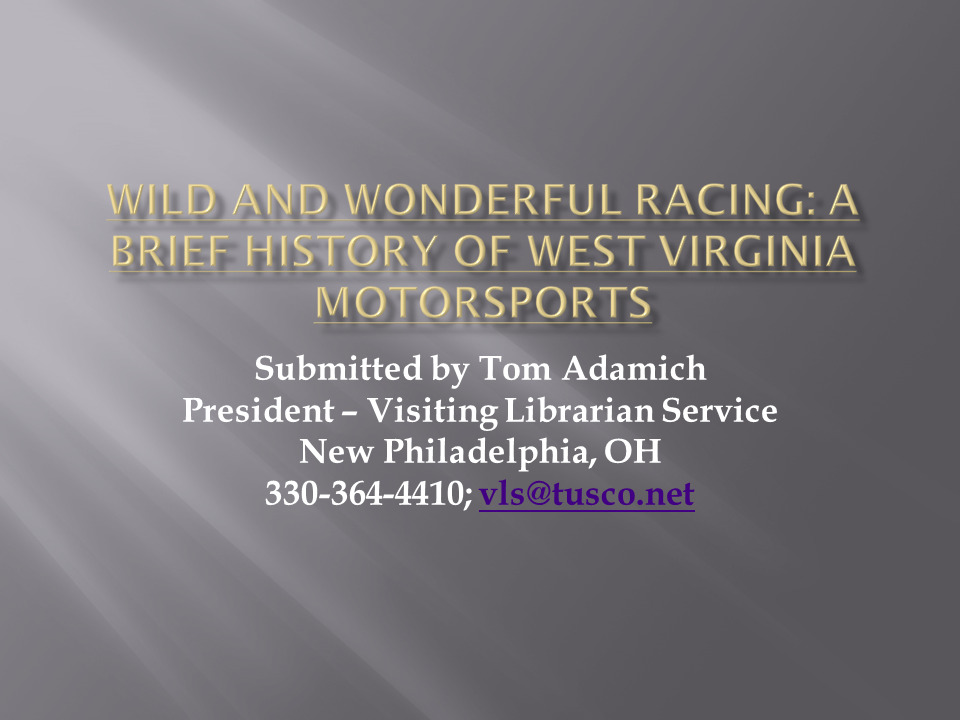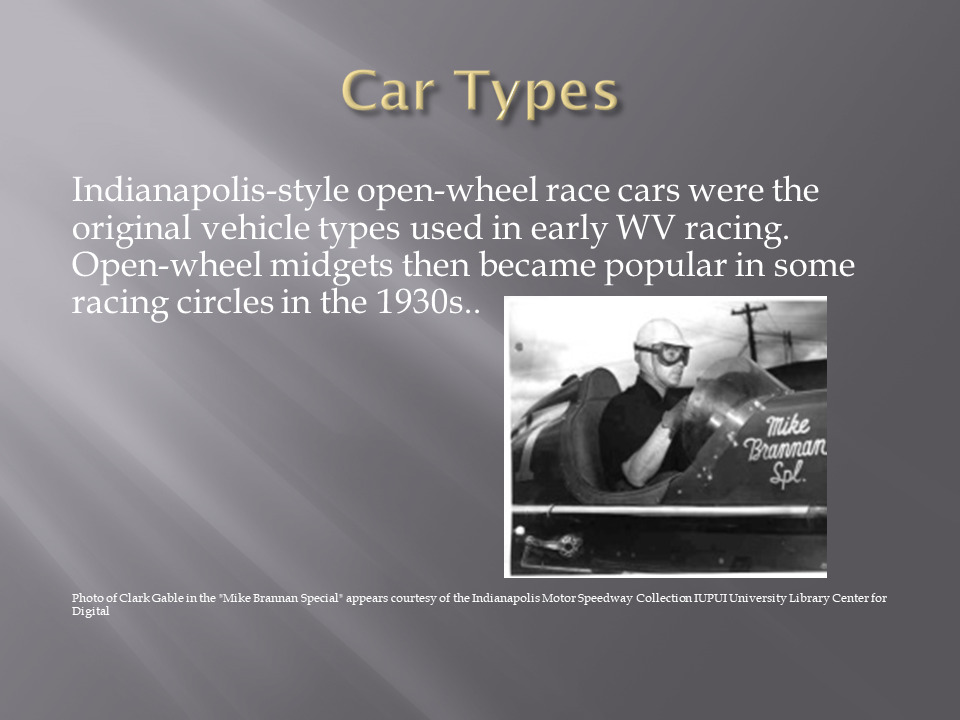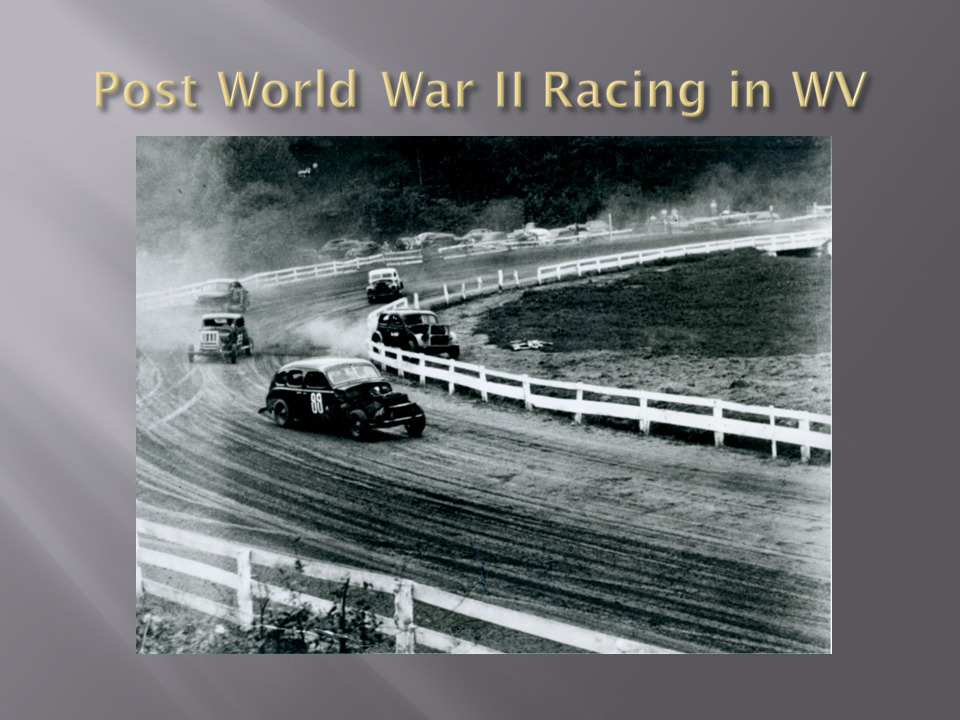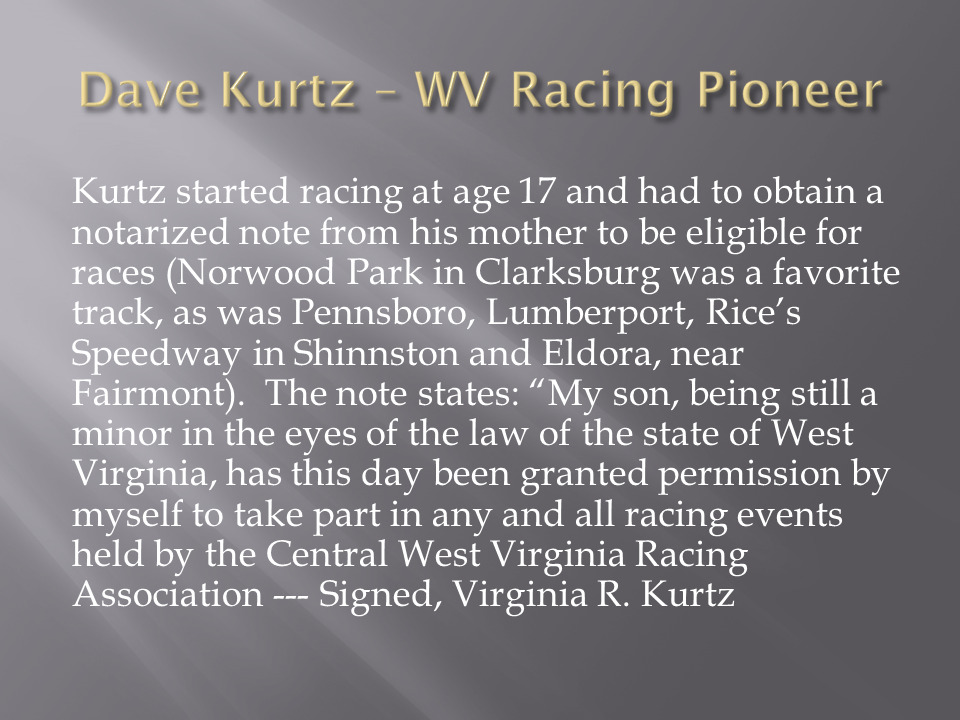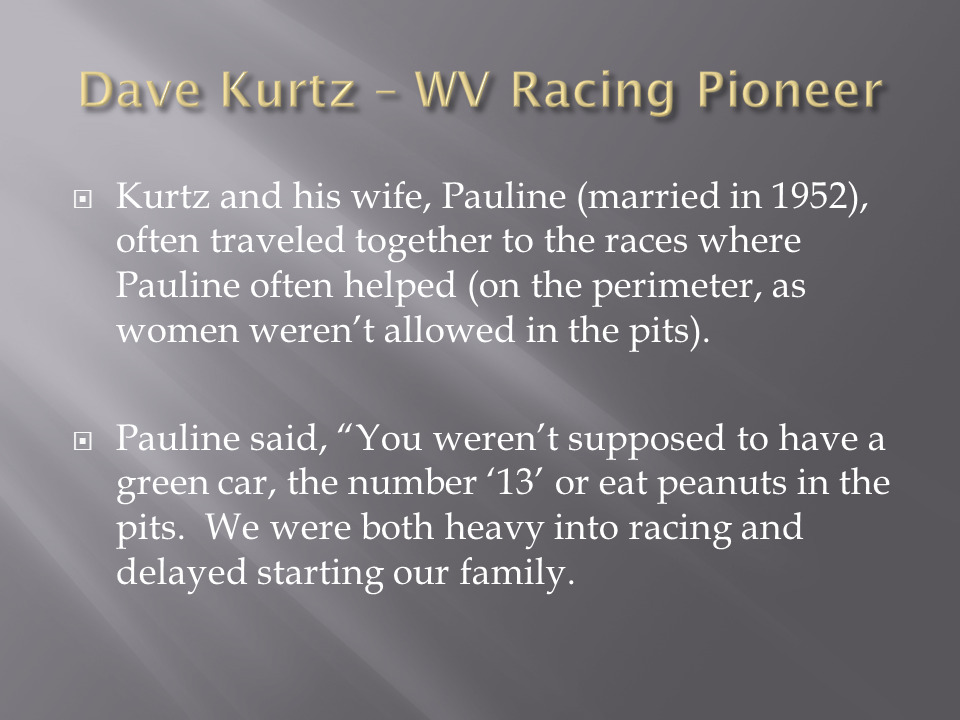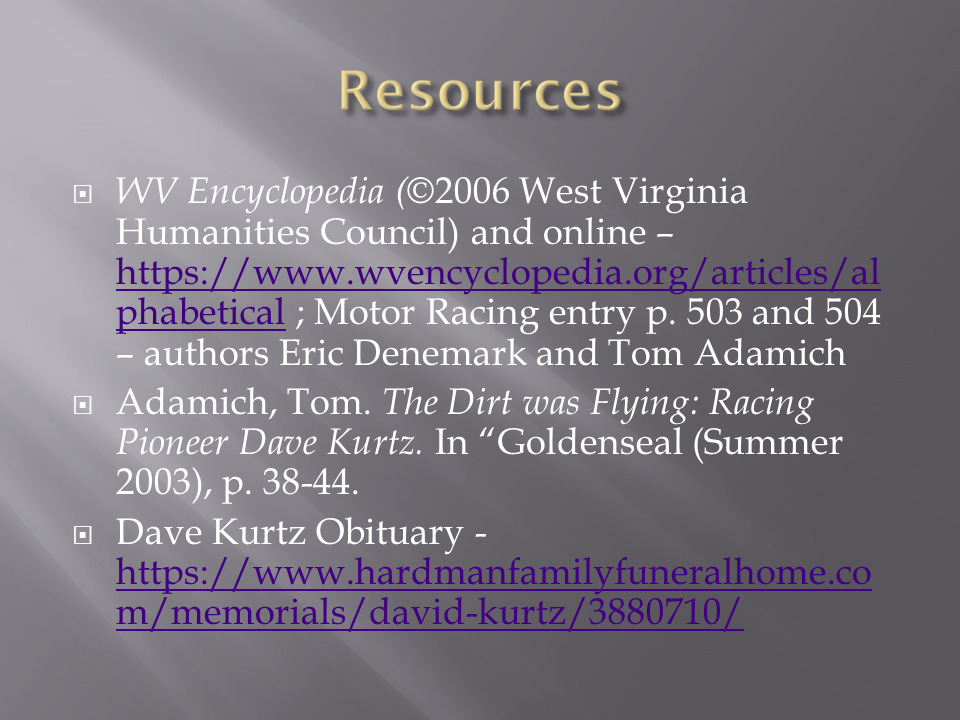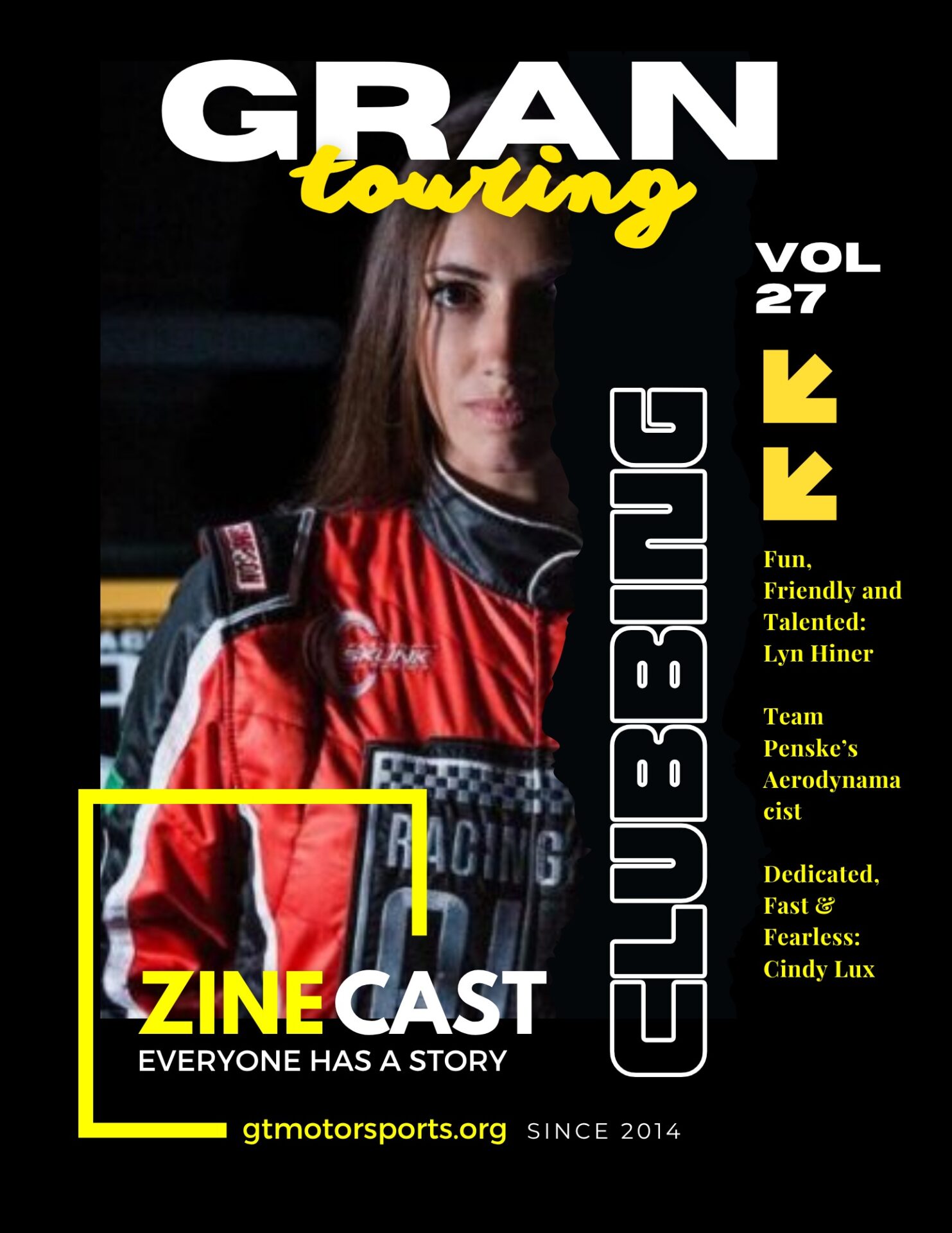Grassroots and bootstraps strategies were used by early racing pioneers in West Virginia beginning in the 1930s. Tom Adamich, co-author of the auto racing entry in the West Virginia Encyclopedia and other related articles/publications will profile several events and individuals who innovated and dominated on the dirt tracks, ball diamonds, and other unique race courses that dot the hills and valleys of the great state of West Virginia.
Tune in everywhere you stream, download or listen!
 |  |  |
- Bio
- Notes
- Transcript
- Livestream
- Highlights
- Learn More
Bio

Tom Adamich has been a vehicle/motorsports historian since the early 1990s. He served as the project archivist at the Wills Sainte Claire Auto Museum (Marysville, Michigan) from 2009-2016. He has been a frequent presenter at the Argetsinger Symposium – including presentations on Strategic Air Command (SAC) racing history, Cuban motorsports history, and Formula Vee.
Notes
Transcript
[00:00:00] Break/Fix’s History of Motorsports series is brought to you in part by the International Motor Racing Research Center, as well as the Society of Automotive Historians, the Watkins Glen Area Chamber of Commerce, and the Argettsinger family.
West Virginia Motorsports History By Tom Adamich. Tom Adamich has been a vehicle and motorsports historian since the early 1990s. He served as the project archivist at the Will St. Clair Auto Museum in Marysville, Michigan from 2009 to 2016. He has been a frequent presenter at the Artsinger Symposium, including presentations on strategic air command racing history, Cuban motorsports history, and Formula V.
Grassroots and bootstrap strategies were used by early racing pioneers in West Virginia beginning in the 1930s. Adamitch, co author of the auto racing entry in the West Virginia Encyclopedia and other related articles and publications, will profile several events and individuals who [00:01:00] innovated and dominated on the dirt tracks, ball diamonds, and other unique race courses that dot the hills and valleys of the great state of West Virginia.
Tom, we’re going to talk about West Virginia motorsports history. My name is Tom Adamich. I’m the president of Visiting Librarian Service, and I have been in that role for 30 years. I’m an archivist and a librarian and a vehicle historian. I’ve been a member of SAH since 1993. I’ve been a member of the National Association of Automobile Museums since 1998.
I’m a humble servant in that I’ve had the pleasure of getting to know many of you through this symposium. It has been one of the great opportunities to share information, particularly on motorsports. Tom, what in the world possessed you to look into this topic? Understanding that racing really… Is that grassroots type of activity, even in its upper [00:02:00] echelons as it becomes that business model.
And I think there’s still that local aspect of people getting together that people enjoy vehicles. They enjoy the mechanical aspect of creating something out of nothing. And they still do it. Believe me, even where I live in Ohio, there’s still these small tracks all over the place where people get together and they have modified stocks and all those things.
And the young kids, that’s what’s heartening, that a lot of these kids learn skills and they’re still doing it. And of course, the time that I did work in West Virginia and I met a lot of good people, and wanting to know what did it look like at different times in the state, and to be really somewhat surprised at times that the Area had such a very successful and still does a very successful racing climate today.
I’m going to talk about something that is in line with some of my past presentations. Keep [00:03:00] in mind that theme of the populace, the people and some of the spirit that they have to make something out of nothing. Particularly, look at the time frame of the history of racing in West Virginia, starting in the early 20th century.
A lot of that is historically based, which I think reflects on the spirit of the individuals who were involved. We’re going to look at some of those early years, and we’re talking starting in the late teens and early 20s. Progressing through particularly jumping forward, then following World War 2 because of some of the issues that racing faced during the war, then we will focus on some of the good people.
And then we’ll just briefly talk about a racing today in West Virginia. And some of the future opportunities that may exist. I like to say that a lot of the people who are involved in racing in West Virginia are probably part of that [00:04:00] camp that dealt with the fact that they were just in the right place at the right time.
And that history was on their side and I think when you look back, you can say that a lot of this is very true. 1 of the most interesting parts of early racing was the fact that it took place in small venues. Venues that would not have been thought of as being appropriate. Some early racing took place on ball fields and some very grassy areas that were available.
And of course, venues that were part of county fairs and those activities were very popular early on. The idea of racing on a harness racing track was very appealing. And it helped to really start the development of racetracks throughout West Virginia, various regions of the state progressed at different times.
The northern part of West Virginia, somewhat close [00:05:00] to the Ohio border really was 1 of the 1st areas that developed probably because of that influence of Ohio and Pennsylvania. The population center for those of you who know West Virginia still is based in Charleston in the capital. It was a logical choice for development and Dunbar, which is in that South Metro Charleston area was 1 of the biggest.
Early tracks, they started the mid teens to have auto racing and motorcycles and I include that because again, our motor sports focus, you know, we think of cars, but we want to always be cognizant of some of the other vehicle types that did evolve during that time and the opportunities for racing and competition.
Again, Dunbar was one of those early places, and it really speaks to the fact that there were opportunities for development beyond what had been a traditional harness racing [00:06:00] track. And of course, improvements were very much part of that. In this case, at Dunbar, clay was brought in as a surface. Giving the opportunity for infrastructure to be developed, the pits, including grandstands, and those spectator areas and participant areas, you know, that were also part of that progress.
Racing, as you went into the 20s and the early 30s, most of those open wheel type race cars that we were familiar with from that era, then began to be the dominant vehicle type. Prior to that. Most of the vehicles were modified passenger cars, and you’ll see a trend back to that, but the open wheel cars were very specialized.
And very much targeted toward very organized racing. And this was again the dominant racing type during that period. I jump forward to World War II because I think it’s significant to say that the [00:07:00] war did pause a lot of the racing events. After the war, the pent up demand that did exist was really what gave the sport, especially in the state, that real catalyst to move forward and become extremely popular, especially for the working folks.
There was a lot of manufacturing that did exist within the state, especially in that area. On the Ohio and West Virginia border, and in the Charleston segment, and over into Huntington to the West and Eastern Kentucky. Other parts of the state as populations and opportunities existed, they developed tracks.
St. Albans became a big racing venue as did Scott field. And Gillen Park at Parkersburg had a lot of industrial influence as did Williamson, Glenboro, and Pennsboro. Pennsboro being a location in Ritchie County, which is in that region. And then as you went [00:08:00] west to Wellsburg and Weston, and then further west.
Into the areas of Morgantown, which had a big steel area that not a lot of people know about, but definitely connected to its influence from Pittsburgh. But I mentioned that because as we get into some of these locations, you’ll see how some of that post war opportunity influenced the development.
Notably, that Evans being one of the first tracks to have lights back in 1947. So again, they were putting resources into these venues, and they became very popular. Going back to that modified stock car, what became a stock car, and the good people who were very ingenious and inventive to make something out of nothing.
I had the pleasure of meeting Dave Kurtz and his lovely wife. I worked briefly for the state of West Virginia for the library commission. And I drove from Charleston. They lived in Weston. I drove [00:09:00] east to visit them. He started racing at age 17. He actually had to get a note from his mother because he was underage.
And so you can think back and, and look at some of the things today and, and that’s kind of an interesting juxtaposition that somebody had to go through that. But there again. People were very industrious and inventive, as they are today. Young people find a way, and he did. He enjoyed racing at Norwood Park, which was in Clarksburg, and then at the Pensborough Rice Speedway, which is in Simpson, and some of the areas.
In that region, including Eldora Raceway in Fairmont, he was part of that Central West Virginia Racing Association organization that developed, and there were several of those throughout the state that were the oversight bodies for the sport. This is the part I always enjoy. He was able to take a football helmet and some pipe and bail wire that he [00:10:00] had around to make that roll cage that he used.
And he used the army pistol belt that a family member was in the war, had worn when he was in the war. Thank goodness he had that roll cage, because he was not immune to having rollovers and things happen to him. No injuries, but as you can see, he, to the right, he’s already up and about. Dave was a resourceful gentleman, so.
One story, they bought a car from an old lady. They found this car and the lady said, Here it is. I don’t have a title on it. I’ll sell it to you. Of course, it was one that had been sitting outside and the bees got into it. And his friend that he went with was in that position of dealing with it. But there again, Mr.
Kurtz really represents that person who could, again, make something out of nothing. Some of the things that he did were just very inventive. And I think represented the common people and what they were trying to do and accomplish in the [00:11:00] sport. Dave got involved in some product testing for NASCAR, that he was part of that initiative for Monte Ward.
And then he went on and raced in those early races at venues that we’re familiar with, as far as NASCAR is concerned. Just kind of some neat. Things that happened to the people as they were trying to create their team, trying to create their racing opportunities. I go back and I referenced his wife, Pauline, cause she was just the nicest lady.
God bless her. As far as somebody who was industrious, she was just as industrious as he was. To be able to help him, and she even helped in the pits when she could. This was back in the day when the ladies weren’t allowed to be working there, but she was able to go in there every once in a while, and if he needed something, she would do just as much work as he was doing.
And of course, when they were off track, she did a lot of that, too. They decided when he was going to retire [00:12:00] when she had her first babies. She was pregnant, so he was honored his word, but by golly, he got drawn into a race and won the money. Then they were able to use that money for the birth of their first daughter.
She passed away a few years after I talked with them. And then Dave passed away in 2019. So it’s kind of a trip down memory lane for me that it was such a nice trip out to talk with them. Just one of those things that is in the right place at the right time, I think, and represents that spirit of the sport and why racing is still popular with people, because I think it does represent that common interest and so on.
And again, here’s some friends of his that were part of that early racing. Monty Ward in particular was a very successful racer during that time. And these people throughout the state of West Virginia represented the different regions of the state. I wrote an article that appeared in the state magazine Golden Seal [00:13:00] as a result of that.
As I mentioned earlier, parts of the state developed at different times, but even around Morgantown that became a very popular venue for racing. Today, there’s been a lot of Activity at the legislative level, and that’s a place, even when I was in the state, people in Charleston were trying to promote it and they had a motor sports commission developed during that time.
But this is the latest iteration of the West Virginia motor sports committee. And again, the emphasis is not only on auto racing, but it does involve a lot of other types of vehicle racing and motocross and those types of activities. They promote the different areas, and these are the dedicated facilities that exist today, areas that are dedicated to track racing, but also this Hatfield McCoy Trail, which if any of you have an inclination to [00:14:00] learn more about that, please let me know, because it’s a very interesting development.
It really lends itself to types of vehicles that are on there and its relationship to people enjoying the sports and what develops and how they can participate. You get to learn a lot about geography at West Virginia, which for any of you that have been there, it is God’s country because of its many little valleys.
And haulers as the natives call it and river bottoms and things like that, that really give it its unique character. It’s just a good way to learn not only about racing, but about where the people lived and what they did. So it has evolved a bit. It’s a little bit more technologically advanced and a little bit more expensive.
Some of those people have to invest a good amount of money, but there again, the intent. And the idea is to enable people to enjoy and [00:15:00] participate and they’re historically able to do so. Looking at timeframes history without that context of what the history is at the time, sometimes we miss what really is there.
And in this case, we have to look at today and see what our economic conditions are and, and some of that to really get a sense of. Today’s activities. It continues to be a story that evolves and one that will continue to require making improvements and things that will be part of that as the industry continues to develop.
Particularly in the early 2000s, there was that big move to try to have a NASCAR venue set up in the state, and I think there’s still some movement there, not as much as it was, but there’s always that interest in having some type of influence NASCAR wise. In the state, we’ll see where that comes. And again, just a lot of good people that live [00:16:00] there.
They’re just friendly folks. You all come, you know, they’re very welcoming in that sense. They do represent motor sports very well in that regard. And I encourage you to look at the West Virginia encyclopedia. If you’d like to go online, I’m happy to provide this deck for you, if you’re interested, and to answer any questions, and I had a lot of good help from people, folks from the West Virginia Encyclopedia and, and from Golden Seal, who are very much part of that Humanities Council in West Virginia, and very eager to share information and promote the good things that West Virginia has to offer.
And again, I’m happy to talk with any of you, and hopefully, God willing, that we can meet again in the future. Thank you, Tom, once again. West Virginia has a very interesting racing history, and I think Tom covered a lot of that. Hint, hint, hint to some of you. There’s a lot to be covered by racing historians about [00:17:00] West Virginia, and Tom, I think you provided a nice framework for looking into it, because I think it’s one of those types of situations where it kind of gets overlooked.
A lot of connection. Thank you, Tom, for the presentation, and we’re looking forward to having you come back in the future.
This episode is brought to you in part by the International Motor Racing Research Center. Its charter is to collect, share, and preserve the history of motorsports, spanning continents, eras, and race series. The center’s collection embodies the speed, drama, and camaraderie of amateur and professional motor racing throughout the world.
The Center welcomes serious researchers and casual fans alike to share stories of race drivers, race series, and race cars captured on their shelves and walls and brought to life through a regular calendar of public lectures and special events. To learn more about the Center, visit www. racingarchives.
org. This episode is also brought to you by the Society of Automotive Historians. They encourage research into any aspect [00:18:00] of automotive history. The SAH actively supports the compilation and preservation of papers. Organizational records, print ephemera and images to safeguard as well as to broaden and deepen the understanding of motorized wheeled land transportation through the modern age and into the future.
For more information about the SAH, visit www. autohistory. org.
We hope you enjoyed another awesome episode of Brake Fix Podcast brought to you by Gran Touring Motorsports. If you’d like to be a guest on the show or get involved, be sure to follow us on all social media platforms at GrandTouringMotorsports. And if you’d like to learn more about the content of this episode, be sure to check out the follow on article at GTMotorsports.
org. We remain a commercial free and no annual fees organization through our sponsors, but also through the generous support of our fans, families, and friends through Patreon. For as little as [00:19:00] 2. 50 a month, you can get access to more behind the scenes action, additional Pit Stop minisodes, and other VIP goodies, as well as keeping our team of creators Fed on their strict diet of fig Newtons, gumby bears, and monster.
So consider signing up for Patreon today at www. patreon. com forward slash GT motorsports, and remember without you, none of this would be possible.
Livestream
Highlights
Skip ahead if you must… Here’s the highlights from this episode you might be most interested in and their corresponding time stamps.
- 00:00 Introduction and Sponsors
- 00:16 Meet Tom Adamich: Motorsports Historian
- 00:43 Early Racing in West Virginia
- 01:09 Tom Adamich’s Background and Passion
- 01:51 Grassroots Racing Culture
- 04:12 Historical Racing Venues
- 06:54 Post-War Racing Boom
- 08:47 Dave Kurtz: A Racing Legend
- 13:13 Modern Racing and Future Prospects
- 16:46 Conclusion and Acknowledgements
Learn More
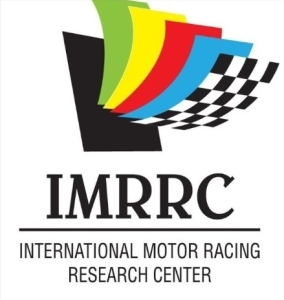 If you enjoyed this History of Motorsports Series episode, please go to Apple Podcasts and leave us a review. That would help us beat the algorithms and help spread the enthusiasm to others. Subscribe to Break/Fix using your favorite Podcast App:
If you enjoyed this History of Motorsports Series episode, please go to Apple Podcasts and leave us a review. That would help us beat the algorithms and help spread the enthusiasm to others. Subscribe to Break/Fix using your favorite Podcast App: |  |  |
Consider becoming a Patreon VIP and get behind the scenes content and schwag from the Motoring Podcast Network
Do you like what you've seen, heard and read? - Don't forget, GTM is fueled by volunteers and remains a no-annual-fee organization, but we still need help to pay to keep the lights on... For as little as $2.50/month you can help us keep the momentum going so we can continue to record, write, edit and broadcast your favorite content. Support GTM today! or make a One Time Donation.
This episode is sponsored in part by: The International Motor Racing Research Center (IMRRC), The Society of Automotive Historians (SAH), The Watkins Glen Area Chamber of Commerce, and the Argetsinger Family – and was recorded in front of a live studio audience.
Other episodes you might enjoy
Michael R. Argetsinger Symposium on International Motor Racing History
 The International Motor Racing Research Center (IMRRC), partnering with the Society of Automotive Historians (SAH), presents the annual Michael R. Argetsinger Symposium on International Motor Racing History. The Symposium established itself as a unique and respected scholarly forum and has gained a growing audience of students and enthusiasts. It provides an opportunity for scholars, researchers and writers to present their work related to the history of automotive competition and the cultural impact of motor racing. Papers are presented by faculty members, graduate students and independent researchers.The history of international automotive competition falls within several realms, all of which are welcomed as topics for presentations, including, but not limited to: sports history, cultural studies, public history, political history, the history of technology, sports geography and gender studies, as well as archival studies.
The International Motor Racing Research Center (IMRRC), partnering with the Society of Automotive Historians (SAH), presents the annual Michael R. Argetsinger Symposium on International Motor Racing History. The Symposium established itself as a unique and respected scholarly forum and has gained a growing audience of students and enthusiasts. It provides an opportunity for scholars, researchers and writers to present their work related to the history of automotive competition and the cultural impact of motor racing. Papers are presented by faculty members, graduate students and independent researchers.The history of international automotive competition falls within several realms, all of which are welcomed as topics for presentations, including, but not limited to: sports history, cultural studies, public history, political history, the history of technology, sports geography and gender studies, as well as archival studies. The symposium is named in honor of Michael R. Argetsinger (1944-2015), an award-winning motorsports author and longtime member of the Center's Governing Council. Michael's work on motorsports includes:
The symposium is named in honor of Michael R. Argetsinger (1944-2015), an award-winning motorsports author and longtime member of the Center's Governing Council. Michael's work on motorsports includes:- Walt Hansgen: His Life and the History of Post-war American Road Racing (2006)
- Mark Donohue: Technical Excellence at Speed (2009)
- Formula One at Watkins Glen: 20 Years of the United States Grand Prix, 1961-1980 (2011)
- An American Racer: Bobby Marshman and the Indianapolis 500 (2019)




